- October 17, 2024
- Comments (0)
Air traffic control (ATC) is an essential component of the aviation industry, ensuring the safe and efficient movement of aircraft within Indian airspace. As the aviation sector in India continues to expand, the role of air traffic controllers becomes increasingly vital. This blog will delve into the workings of air traffic control in India. Highlights the significance of airports managed by AAI and pilot training at such airports. An excellent example is DUNES AVIATION ACADEMY operating its exceptional pilot training from an AAI controlled airport, Bhavnagar Gujarat
The primary responsibility of air traffic controllers is to maintain safety in the skies. They monitor aircraft movements, preventing collisions and ensuring that planes maintain safe distances from one another. This involves constant communication with pilots, providing crucial information such as weather updates and runway conditions. The effectiveness of ATC is paramount, especially in a country like India, where air traffic is on the rise.
Managing air traffic flow is another critical function of ATCs. Utilizing advanced radar systems and communication tools, controllers track aircraft and provide instructions regarding takeoff, landing, and navigation. This meticulous management helps prevent congestion and delays, ensuring that flights operate smoothly. For instance, Bhavnagar Airport, located in Gujarat, plays a significant role in regional aviation, serving as a hub for both commercial and general aviation traffic. The airport’s strategic location allows ATCs to efficiently manage air traffic, showcasing their essential functions in real-time operations.
In addition to safety and flow management, air traffic controllers provide navigation assistance to pilots. This is particularly crucial for flights entering or exiting Indian airspace, as ATCs guide them through a complex network of airways while adhering to international regulations. Furthermore, in emergency situations, ATCs coordinate responses, working closely with ground services to ensure swift action, which can be life-saving.
Effective communication is the cornerstone of ATC operations. Controllers must convey clear and concise instructions to pilots, using standardized phrases to eliminate misunderstandings. They also collaborate with other controllers, both domestically and internationally, to facilitate the seamless transfer of aircraft between airspaces.
Training and qualifications for air traffic controllers in India are rigorous. The Airports Authority of India (AAI) oversees the training and certification process, ensuring that controllers possess the necessary theoretical knowledge and practical skills. Dunes Aviation Academy, located near Bhavnagar Airport, is a prominent institution offering comprehensive training programs. The academy provides students with state-of-the-art facilities and experienced instructors, preparing them for successful careers in the aviation industry.
As India’s aviation sector continues to grow, the demand for skilled air traffic controllers is increasing. The AAI is investing in modern technology and infrastructure to enhance the efficiency of ATC systems, including advanced radar and satellite-based navigation aids.
In conclusion, air traffic controllers are the unsung heroes of the aviation industry, ensuring the safety and efficiency of air travel in India. Their collaboration with airports like Bhavnagar and training institutions like Dunes Aviation Academy underscores the commitment to developing a robust air traffic control system, essential for managing the complexities of modern aviation.
Happy Flying !!
